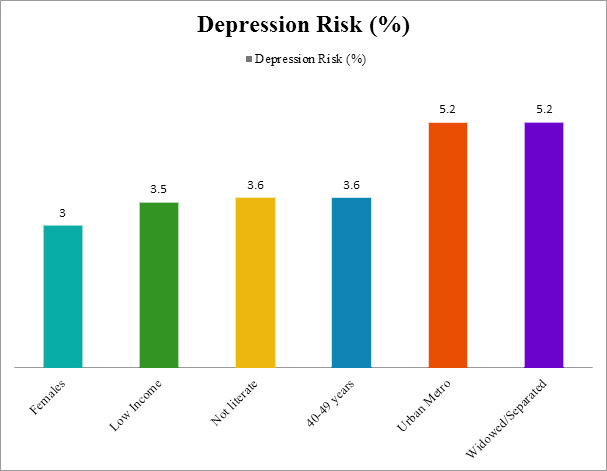Drumroll, followed by depression?
Depression is becoming an increasingly prevalent condition in India, given the race for jobs, breaking relationships, and consequently rocketing levels of stress. In most cases, depression goes undiagnosed, and in some, there is no affordability to treat it clinically. This arises from the stigma surrounding taking help for it, which forces people to hide issues relating to their mental wellness. A quick look at data from the National Mental Health Survey 2015-16 reveals that depression is most prevalent in urban metro areas, and more specifically, amongst widowed/separated women.
The graph shows the percentage of risk of women from different backgrounds being affected by depression. The most glaring numbers belong to the “widowed/separated women” group - 1 out of 20 of these women is a victim of depression. This is obviously a result of sudden death of spouse or abandonment, since an expected death or divorce has very less chances of leading to acute depression. Zeroing in further, Census 2011 data reveals that the number of divorced women in India is around 9,10,000, of whom at least 47,202 women are under depression according to the percentage in the graph below.

The NMHS also states that additionally, 1% of these women are under the risk of suicide, which means that at least 9,100 divorced women unmistakably face extreme mental trauma at some point in their lives. An important fact to be taken note of here is that these are only numbers representing conditions of those willing to open up about their mental wellness. The number of people suffering from depression is grossly underreported due to the fear to admit to its presence (Math & Srinivasaraju, 2010).
The NMHS reveals that the cost of treatment for depression per individual is at least Rs. 1250 per month, and treatment is needed for at least six months.
Following from this brief analysis, it is evident that at least around 56,000 women in India currently require treatment for depression resulting from divorce, or spousal abandonment. This leads to the next, very natural question on the affordability of treatment costs to undo this damage. Again, the NMHS reveals that the cost of treatment for depression per individual is at least Rs. 1250 per month, and treatment is needed for at least six months. Therefore, the cost of treating depression in a woman is around Rs. 7,500 per year. But, the average annual Indian per capita income is Rs. 74,290; in which case, approximately 10% of the annual income of a woman or her family member would have to go towards treatment. An additional roadblock is that depressed women might not be earning members and there might be only one breadwinner in a family of at least three members. How affordable is treatment in this case?
External support is an optional way out – for instance, The Government of India provides for abandoned women through a fund under the National Social Assistance Scheme. There are also a number of non-governmental organisations (NGOs) offering grassroot level interventions to support women in need of counselling for depression or trauma. However, the accessibility of these funds/services is a million dollar question, since most women do not have the resources or energy to prove abandonment in courts, or to even explore the effectiveness of NGO schemes.
Another pertinent question which pops up at this point is whether family courts are the ultimate decision-making authorities to deliver judgments on issues faced by a married couple. Most divorce/abandonment cases in Indian courts work this way – the court issues an order summoning the couple or the deserted woman, and offers around fifteen minutes of counselling. Upon completion of such a session, the court puts off the next hearing to a date months away. A few sessions like these later, there is minimal truth and evidence left to support any argument justifying abandonment or separation, with divorces chiefly happening based on sheer exhaustion. This leaves a permanent, bitter impact on the mind of both the man and the woman – more on the latter, since a few narrow-minded, conservative members of the society tend to largely blame the woman in a marriage gone awry.
How can such a system determine the truth in what transpired between a couple, inside a house? What might be considered as circumstantial evidence might have been a reaction to a greater provocation, making it difficult to point fingers at anyone. What, then, is the point of putting both a man and a woman through the trauma and exhaustive process of contesting a case? The time is probably ripe to think of other ways of dealing with such cases of abandonment and divorce. It is essential to conduct mediation/counselling outside the court atmosphere in the presence of the couple/the abandoned woman and an unbiased counsellor, and other family members being present only when required.
Globally, there have been several examples of lay health workers and members of the community being equipped with basic mental health problem detection skills and counselling expertise. Sangath, BALM (The Banyan Academy of Leadership in Mental Health) and The Schizophrenia Research Foundation (SCARF) are nonprofit organisations in India which have attempted some community-level interventions to address mental health issues. However, there is still a need to equip agents of change to address marital mental trauma issues in particular, especially for women victims of abandonment/divorce, who need the right avenues to escape the horror of lifelong depression.
India, which is home to a fair distribution of institutions offering social work as a course for students, could help students interested in finding fulfilling employment opportunities to provide preliminary counseling to abandoned/divorced women, or couples, for a nominal fee. Though amateurs, these students could very well act as stepping stones to more specific help by referring severely affected women to psychiatrists, and by attempting to offer verbal counselling to those at nascent stages of depression. Until reconciliation or amicable parting of ways of a couple, or even to help a woman come out of the shock of desertion/abandonment, such repeated counselling sessions could save thousands of women from depression, and could also divert them into more lucrative vocations - such as taking up a job or pursuing entrepreneurship. Preliminary counselling is a significant step towards eliminating the issue of affordability of mental healthcare for depression in such women – and it is high time interventions measuring their impact are carried out.

About Neharika
Neharika Rajagopalan is currently a Senior Policy Associate at IFMR LEAD, one of the leading research organisations in South Asia.
She has previously worked with Ernst & Young LLP and the Indian Council for Research on International Economic Relations (ICRIER), and the Asia Society for Social Improvement and Sustainable Transformation (ASSIST). She holds an M.Sc. in Economics from the University of Warwick and did her undergraduate degree at the Ethiraj College for Women, Chennai, India.
While she was at Warwick, she was one of the executive team members who initiated the Warwick Economics Exchange in 2013, and also maintained a blog when she studied there, which summarised weekly student sessions of the Warwick Economics Research Lounge series.
Since the past 6 years, she has also been and continues to be a freelance writer - she has contributed articles to popular dailies in India such as The Hindu, The Business Line and The Deccan Herald and other online forums, apart from writing on her blog occasionally and pursuing singing opportunities in Carnatic Music. She has also taught three modules on economic development at the Banyan Academy of Leadership in Mental Health, to postgraduate students of social work & psychology. She is also a mother to a one-year old boy, Hrudhaiy.
Neharika has also written a number of blog posts on various topics which you can read on her personal blog
